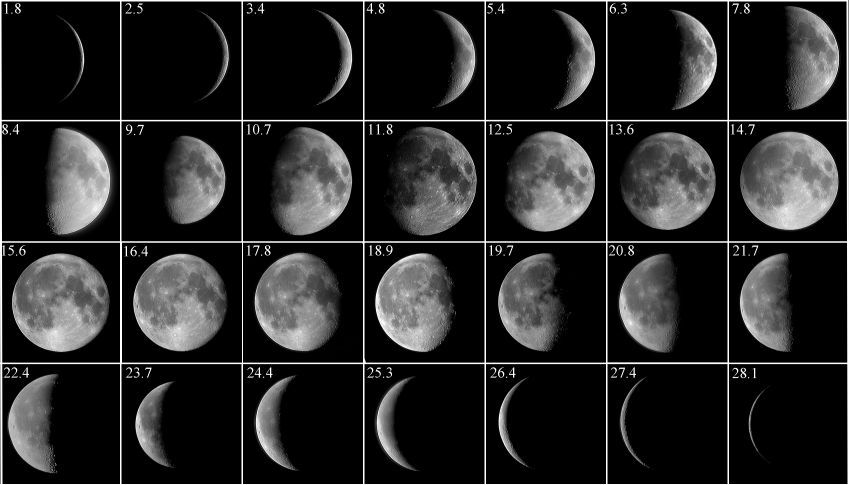

I have collected images of the Moon at each day of a lunar month.
Click on any image to see a full-sized version (<29K);
in some cases I have a mosaic, in which case a link appears alongside the bigger image.
Be aware these mosaics can be quite large files (up to 800K).
The slightly different sizes of the images here are real.
The Moon's distance is not constant so its apparent size depends on where it is in its orbit.
This is well illustrated by the pictures at Day 9.7, which was taken close to apogee (the point in
the Moon's orbit where is is furthest from the Earth), and the picture for Day 10.7, which was taken
when the Moon was close to perigee (the point where it it closest to the Earth).
On Days 6.3 and 8.4 I show good examples of libration.
As of December 2019 I have started to collect high-resolution pictures of the whole Moon using a Canon 1100D DSLR camera and an 8-inch Ritchey-Chrétien telescope. You will find an index to these pictures here. Currently (March 2020) these are in chronological order rather than phase order and there are duplicates, but, when the collection is complete, I shall reorder them into phase order. These pictures are also accessible from the links below, but for historical reasons the way I've done this is not entirely consistent. On the pages linked below, I have retained the older pictures and some older mosaics because I think it is interesting to see how hardware and software techniques have improved since I made the original collection.
Click here to see an index into my large collection of more-detailed pictures of the Moon's craters.

There is more than one way to designate the age of the Moon in days. One way is to divide the lunar cycle of 29.5 days into 29.5 equal parts so that the age at this time tomorrow is exactly one day more than it is now. In my view this is not the best way to do it as the illumination of the Moon does not change evenly because the orbit is not circular. The data used here is from MyStars! and uses the Sun-Moon-Earth angle as a fraction of 360°.
The Moon's orbit is not circular, so it's distance varies as it goes around. The result of this is that at some parts of the lunar month it looks bigger than at others. This is well illustrated by my images at Day 9.7, which was taken only two days after apogee, compared to my image on Day 10.7 which was taken very close to perigee.
 |
Click on this image to access an index to my large collection of more-detailed, lunar images. |